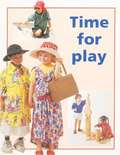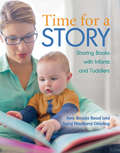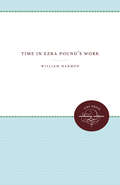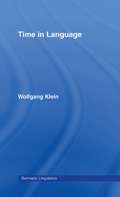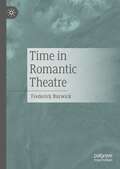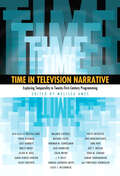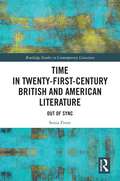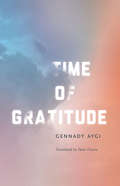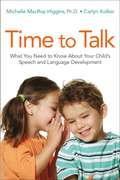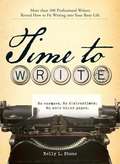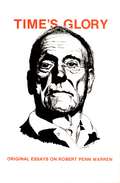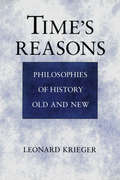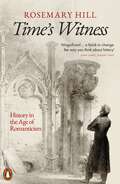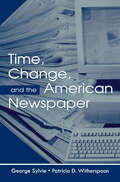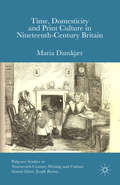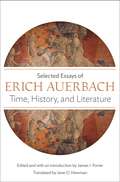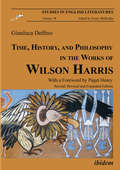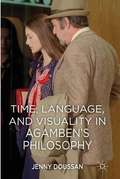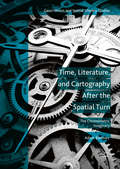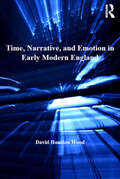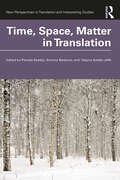- Table View
- List View
Time for Play (Rigby PM Plus Blue (Levels 9-11), Fountas & Pinnell Select Collections Grade 3 Level Q #Red (Levels 3-5))
by John PettittNIMAC-sourced textbook
Time for a Story
by Saroj Ghoting Amy ReadIf you’ve ever tried reading with an infant or toddler, it may look something like this: you sit down on the floor and start reading, and the child pats the pages, chews on the book, or toddles away! With all the signs pointing to disinterest, is it even worth it to read to children from infancy to age two? The answer is yes! Children’s books are tools that prepare young children for later reading success—the way you use books with children makes a difference in their early literacy development. Planning story times with infants and toddlers can be challenging, but with thought and preparation, you can maximize the reading experiences of these little learners! In Time for a Story, explore fun and engaging ways to talk, sing, read, write, and play with young children throughout the day to help them begin developing important pre-literacy skills, including phonological awareness, print awareness, letter knowledge, and background knowledge. These practical techniques will help you put the children in your care on the path to school readiness!
Time in Ezra Pound's Work
by William HarmonThroughout nearly sixty-five of writing, Pound specialized on the suffocating effects of time on poetry, aesthetic form, and history. Harmon examines Pound's strategies for dealing with time and arrives at a persuasive reading of Pound's works in general and of the The Cantos in particular. By concentrating on a single theme and technique, the author demonstrates a coherence in the writing that elucidates the corpus for both the specialist and the casual reader.Originally published in 1977.A UNC Press Enduring Edition -- UNC Press Enduring Editions use the latest in digital technology to make available again books from our distinguished backlist that were previously out of print. These editions are published unaltered from the original, and are presented in affordable paperback formats, bringing readers both historical and cultural value.
Time in Language
by Wolfgang KleinThis book looks at the various ways in which time is reflected in natural language. All natural languages have developed a rich repetoire of devices to express time, but linguists have tended to concentrate on tense and aspect, rather than discourse principles. Klein considers the four main ways in which language expresses time - the verbal categories of tense and aspect; inherent lexical features of the verb; and various types of temporal adverbs. Klein looks at the interaction of these four devices and suggests new or partly new treatments of these devices to express temporality.
Time in Romantic Theatre
by Frederick BurwickThe shift in temporal modalities of Romantic Theatre was the consequence of internal as well as external developments: internally, the playwright was liberated from the old imperative of “Unity of Time” and the expectation that the events of the play must not exceed the hours of a single day; externally, the new social and cultural conformance to the time-keeping schedules of labour and business that had become more urgent with the industrial revolution. In reviewing the theatre of the Romantic era, this monograph draws attention to the ways in which theatre reflected the pervasive impact of increased temporal urgency in social and cultural behaviour. The contribution this book makes to the study of drama in the early nineteenth century is a renewed emphasis on time as a prominent element in Romantic dramaturgy, and a reappraisal of the extensive experimentation on how time functioned.
Time in Television Narrative: Exploring Temporality in Twenty-First Century Programming
by Melissa AmesThis collection analyzes twenty-first-century American television programs that employ temporal and narrative experimentation. These shows play with time, slowing it down to unfold narrative through time retardation and compression. They disrupt the chronological flow of time itself, using flashbacks and insisting that viewers be able to situate themselves in both the present and the past narrative threads. Although temporal play has existed on the small screen prior to the new millennium, never before has narrative time been so freely adapted in mainstream television. The essayists offer explanations for not only the frequency of time-play in contemporary programming, but also the implications of its sometimes disorienting presence.Drawing upon the fields of cultural studies, television scholarship, and literary studies, as well as overarching theories concerning postmodernity and narratology, Time in Television Narrative offers some critical suggestions. The increasing number of television programs concerned with time may stem from any and all of the following: recent scientific approaches to quantum physics and temporality; new conceptions of history and post history; or trends in late-capitalistic production and consumption, in the new culture of instantaneity, or in the recent trauma culture amplified after the September 11 attacks. In short, these televisual time experiments may very well be an aesthetic response to the climate from which they derive. These essays analyze both ends of this continuum and also attend to another crucial variable: the television viewer watching this new temporal play.
Time in Twenty-First-Century British and American Literature: Out of Sync (Routledge Studies in Contemporary Literature)
by Sonia FrontThis book investigates representations of time in twenty‑first‑century Anglo‑American literature. In the digital era, characterized by a new regime of time, fiction offers revisions of prevalent, oppressive notions of time that can serve as productive political strategies to reclaim the agency of the subject. This book discusses literary texts that craft innovative temporal structures out of sync with the new time logic: suspended temporality (Chapter 1); time as a conflation of phenomenological experience and cosmological laws (Chapter 2); previewing the future (Chapter 3); and networked memory (Chapter 4). The proposed politically productive temporalities, such as deep presence or resonance, compatibilism, contingency, and the use of narrative as a chronologizing strategy, ground a vision of change and suggest a way out of the crisis of time. Identifying new timeframes in twenty‑first‑century fiction by an array of writers, this book demonstrates that literature remains a valid medium for theorizing and representing time.
Time of Gratitude
by Peter France Gennady AygiA collection of extraordinary essays by one of the seminal Russian poets of the twentieth century Gennady Aygi’s longtime translator and friend Peter France has compiled this moving collection of tributes dedicated to some of the writers and artists who sustained him while living in the Moscow “underground.” Written in a quiet intensely expressive poetic style, Aygi’s inventive essays blend autobiography with literary criticism, social commentary, nature writing, and enlightening homage. He addresses such literary masters as Pasternak, Kafka, Mayakovsky, Celan, and Tomas Tranströmer, along with other writers from the Russian avant-garde and his native Chuvashia. Related poems by Aygi are also threaded between the essays. Reminiscent of Mandelstam’s elliptical travel musings and Kafka’s intensely spiritual jottings in his notebooks, Time of Gratitude glows with the love and humanity of a sacred vocation. “These leaves of paper," Aygi says, 'are swept up by the whirlwind of festivity; everything whirls—from Earth to Heaven—and perhaps the Universe too begins to swirl. Everything flows together in the rainbow colors and lights of the infinite world of Poetry.'
Time to Talk: What You Need to Know About Your Child's Speech and Language Development
by Carlyn Kolker Michelle MacRoy-HigginsWhen it comes to language acquisition, all parents have questions…and?this invaluable resource?has all the answers.When should I expect my baby&’s first word? Is my toddler on his way to talking soon? Is my child speaking as clearly as her peers? All parents end up thinking questions like these during their children&’s formative years, but too few act on them, assuming the answers are too unpredictable to be certain. Time to Talk answers these questions for the curious parent.Written by an experienced speech-language pathologist and mom, this practical and proactive guide will help parents:Understand the building blocks of speech and languageMonitor progress against expected milestonesEnhance their child&’s communication skillsSpot signs of potential problems with hearing, speech, or language developmentAddress common concerns, such as articulation, late talking, stuttering, dyslexia, etc.Foster literacyRaise bilingual children successfullyYour child&’s language acquisition no longer must be a guessing game for you. From baby&’s first babbling to reading readiness, Time to Talk provides everything a parent needs so this vital fundamental skill doesn&’t have to be left to chance.
Time to Tug
by Cindy Peattie Paula LaRosaTitle contained within StartUp Phonic Core Program. Not Sold Separately
Time to Write
by Kelly L Stone"Okay, no more excuses. Light bulbs went off in my head as I read Kelly L. Stone's Time to Write with its shrewd observations and sage, practical advice for making time to write."-HALLIE EPHRON, author of Writing and Selling Your Mystery Novel. "When it's a writing day, I'm writing. Period." - JODI PICOULT. "If the trouble is just getting started in the morning, I often change my writing place or method." -JENNIFER BLAKE. In Time to Write, more than 100 professional writers from across genres-including Sandra Brown, Catherine Coulter, Wendy Corsi Staub, Merline Lovelace, Steve Berry, Tess Gerritsen, Ann Major, Cherry Adair, Christine Feehan, Julia London, and Eloisa James-share their secrets to finding time to write. And if they could find the time to write, then so can you. The time is now.
Time to Write
by Kelly L. Stone"Okay, no more excuses. Light bulbs went off in my head as I read Kelly L. Stone's Time to Write with its shrewd observations and sage, practical advice for making time to write. "-HALLIE EPHRON, author of Writing and Selling Your Mystery Novel. "When it's a writing day, I'm writing. Period. " - JODI PICOULT. "If the trouble is just getting started in the morning, I often change my writing place or method. " -JENNIFER BLAKE. In Time to Write, more than 100 professional writers from across genres-including Sandra Brown, Catherine Coulter, Wendy Corsi Staub, Merline Lovelace, Steve Berry, Tess Gerritsen, Ann Major, Cherry Adair, Christine Feehan, Julia London, and Eloisa James-share their secrets to finding time to write. And if they could find the time to write, then so can you. The time is now.
Time's Glory: Original Essays on Robert Penn Warren
by James A. Grimshaw Jr.Robert Penn Warren, the first U.S. Poet Laureate, has received every honor this country can bestow on a writer. Warren has written fiction, nonfiction, and poetry, and has proven to be one of the most versatile writers in modern times. Now, seven original essays on Warren's writing, written by leading scholars and students, have been brought together in one volume. In Warren's fiction sloth, or acedia, is the deadliest of sins. Frances Bixler examines this theme as it courses through five novels. World Enough and Time and The Cave both are analyzed in chapters of their own. Warren's volume of poetry Altitudes and Extensions is given a close reading, while his nonfiction works, particularly The Legacy of the Civil War and Jefferson Davis Gets His Citizenship Back, are also critiqued. The breadth and depth of Robert Penn Warren's canon of work are illustrated by the essays collected by James A. Grimshaw, Jr. Although many books have been written on Warren and his work, to cover such a wide range of his work in one volume is a rare achievement. James A. Grimshaw, Jr., is a professor in, and head of, the Department of Literature and Languages at East Texas State University. His publications include Robert Penn Warren: A Descriptive Bibliography and Robert Penn Warren's "Brother to Dragons": A Discussion .
Time's Reasons: Philosophies of History Old and New
by Leonard KriegerThis original work caps years of thought by Leonard Krieger about the crisis of the discipline of history. His mission is to restore history's autonomy while attacking the sources of its erosion in various "new histories," which borrow their principles and methods from disciplines outside of history. Krieger justifies the discipline through an analysis of the foundations on which various generations of historians have tried to establish the coherence of their subject matter and of the convergence of historical patterns. The heart of Krieger's narrative is an insightful analysis of theories of history from the classical period to the present, with a principal focus on the modern period. Krieger's exposition covers such figures as Ranke, Hegel, Comte, Marx, Acton, Troeltsch, Spengler, Braudel, and Foucault, among others, and his discussion involves him in subtle distinctions among terms such as historism, historicism, and historicity. He points to the impact on history of academic political radicalism and its results: the new social history. Krieger argues for the autonomy of historical principles and methods while tracing the importation in the modern period of external principles for historical coherence. Time's Reasons is a profound attempt to rejuvenate and restore integrity to the discipline of history by one of the leading masters of nineteenth- and twentieth-century historiography. As such, it will be required reading for all historiographers and intellectual historians of the modern period.
Time's Witness: History in the Age of Romanticism
by Rosemary HillFrom the Wolfson Prize-winning author of God's Architect: Pugin and the Building of Romantic BritainBetween the fall of the Bastille in 1789 and the opening of the Great Exhibition in 1851, history changed. The grand narratives of the Enlightenment, concerned with kings and statesmen, gave way to a new interest in the lives of ordinary people. Oral history, costume history, the history of food and furniture, of Gothic architecture, theatre and much else were explored as never before. Antiquarianism, the study of the material remains of the past, was not new, but now hundreds of men - and some women - became antiquaries and set about rediscovering their national history, in Britain, France and Germany.The Romantic age valued facts, but it also valued imagination and it brought both to the study of history. Among its achievements were the preservation of the Bayeux Tapestry, the analysis and dating of Gothic architecture, and the first publication of Beowulf. It dispelled old myths, and gave us new ones: Shakespeare's birthplace, clan tartans and the arrow in Harold's eye are among their legacies. From scholars to imposters the dozen or so antiquaries at the heart of this book show us history in the making.
Time, Change, and the American Newspaper (Routledge Communication Series)
by George Sylvie Patricia D. WitherspoonTime, Change, and the American Newspaper focuses on newspapers as organizations, examining the role of change in the newspaper industry and providing a model from which to view and respond to change. Authors George Sylvie and Patricia D. Witherspoon discuss environmental and organizational influences on contemporary newspapers, and they analyze newspapers within the larger context of all organizations. This more general perspective provides insights into the nature of change, the change process, the rationale for organizational changes, resistance to such changes, and initiation and implementation strategies. In its examination of change, this volume explores the causes of newspaper change, how newspaper change takes shape, and when change does not work. This consideration sets the stage for detailed case studies examining the roles of new technology, product, and people as change agents in newspapers. The discussion concludes with the impact of change--or lack of it--on the contemporary newspaper industry and the subsequent impact of newspaper change on society. Sylvie and Witherspoon propose future directions of change and of newspaper decision-making processes pertaining to change, and they offer suggestions for changes in newspaper structures and thought processes. Providing a sound, theoretically-based approach to the topic of change and American newspapers, this volume is essential reading for educators and students in journalism, media/newsroom management, media economics, organizational behavior/communication, and related areas. It also provides a wealth of insights and practical knowledge for newspaper publishers, editors, and practicing journalists.
Time, Domesticity and Print Culture in Nineteenth-Century Britain (Palgrave Studies in Nineteenth-Century Writing and Culture)
by M. DamkjærThis innovative study shows that nineteenth-century texts gave domesticity not just a spatial but also a temporal dimension. Novels by Dickens and Gaskell, as well as periodicals, cookery books and albums, all showed domesticity as a process. Damkjær argues that texts' material form had a profound influence on their representation of domestic time.
Time, History, and Literature: Selected Essays of Erich Auerbach
by Erich AuerbachImportant essays from one of the giants of literary criticism, including a dozen published here in English for the first timeErich Auerbach (1892-1957), best known for his classic literary study Mimesis, is celebrated today as a founder of comparative literature, a forerunner of secular criticism, and a prophet of global literary studies. Yet the true depth of Auerbach's thinking and writing remains unplumbed. Time, History, and Literature presents a wide selection of Auerbach's essays, many of which are little known outside the German-speaking world. Of the twenty essays culled for this volume from the full length of his career, twelve have never appeared in English before, and one is being published for the first time.Foregrounded in this major new collection are Auerbach's complex relationship to the Judaeo-Christian tradition, his philosophy of time and history, and his theory of human ethics and responsible action. Auerbach effectively charts out the difficult discovery, in the wake of Christianity, of the sensuous, the earthly, and the human and social worlds. A number of the essays reflect Auerbach's responses to an increasingly hostile National Socialist environment. These writings offer a challenging model of intellectual engagement, one that remains as compelling today as it was in Auerbach's own time.
Time, History, and Philosophy in the Works of Wilson Harris
by Gianluca DelfinoGianluca Delfino's study of one of the Caribbean's most controversial authors paves the way for looking at Wilson Harris's body of work in a new light. Harris's imaginative approach to reality is discussed in relation to the categories of history and time with reference to several novels, with a special focus on The Infinite Rehearsal, Jonestown, and The Dark Jester, spanning more than forty years of his vast literary production. Delfino's analysis, encompassing critical perspectives ranging from African philosophy to Jungian readings through historiography and anthropology, demonstrates that Harris's works as a whole show a remarkable unity of thought rooted in their author's complex imagination. As a result, the cross-cultural quality of Harris's thought emerges as a healing outcome of the traumatic colonial encounter, bringing together elements of Amerindian, African, and European origin in an ongoing dialogue with time, nature, and the psyche.
Time, History, and Philosophy in the Works of Wilson Harris (Studies in English Literatures #18)
by Gianluca DelfinoGianluca Delfino's encounter with one of the Caribbean's most controversial authors illuminates Wilson Harris's imaginative approach to history and time. Delfino references several novels, with a special focus on The Infinite Rehearsal (1987), Jonestown (1996), and The Dark Jester (2001). His analysis encompasses critical perspectives from African philosophy to Jungian readings, refracted through historiography and anthropology, demonstrating the remarkable unity that binds four decades of Harris's work. As a result, the cross-cultural quality of Harris's thought emerges as a healing outcome of the traumatic colonial encounter, bringing together elements of Amerindian, African, and European origin in an ongoing dialogue with time, nature, and the psyche.
Time, Language, and Visuality in Agamben’s Philosophy
by Jenny DoussanGiorgio Agamben, a philosopher both celebrated and reviled, is among the prominent voices in contemporary Italian thought today. His work, which touches upon fields as diverse as aesthetics and biopolitics, is often understood within a framework of Aristotelian potentiality. With this incisive critique, Doussan identifies a different tendency in the philosopher's work, an engagement with the problem of time that is inextricably bound up with language and visuality. Founded in his early writings on metaphysics and continuing to his present occupation with inoperativity, Time, Language and Visuality in Agamben's Philosophy forges an original path through Agamben's extensive commentary on the linguistic and the visual to illuminate the recurrent temporal theme of capture and evasion the cat-and-mouse game that bears the foundational violence of not just representation but concept-formation itself. In the process, Doussan both reveals its limit and establishes a ground for future engagements. "
Time, Literature, and Cartography After the Spatial Turn
by Adam BarrowsTime, Literature and Cartography after the Spatial Turn argues that the spatial turn in literary studies has the unexplored potential to reinvigorate the ways in which we understand time in literature. Drawing on new readings of time in a range of literary narratives, including Vladimir Nabokov's Ada and James Joyce's Finnegans Wake, Adam Barrows explores literature's ability to cartographically represent the dense and tangled rhythmic processes that constitute lived spaces. Applying the insights of ecological resilience studies, as well as Henri Lefebvre's late work on rhythm to literary representations of time, this book offers a sustained examination of literature's "chronometric imaginary": its capacity to map the temporal relationships between the human and the non-human, the local and the global.
Time, Narrative, and Emotion in Early Modern England (Literary And Scientific Cultures Of Early Modernity Ser.)
by David Houston WoodExploiting a link between early modern concepts of the medical and the literary, David Houston Wood suggests that the recent critical attention to the gendered, classed, and raced elements of the embodied early modern subject has been hampered by its failure to acknowledge the role time and temporality play within the scope of these admittedly crucial concerns. Wood examines the ways that depictions of time expressed in early modern medical texts reveal themselves in contemporary literary works, demonstrating that the early modern recognition of the self as a palpably volatile entity, viewed within the tenets of contemporary medical treatises, facilitated the realistic portrayal of literary characters and served as a structuring principle for narrative experimentation. The study centers on four canonical, early modern texts notorious among scholars for their structural- that is, narrative, or temporal- difficulties. Wood displays the cogency of such analysis by working across a range of generic boundaries: from the prose romance of Philip Sidney's Arcadia, to the staged plays of William Shakespeare's Othello and The Winter's Tale, to John Milton's stubborn reliance upon humoral theory in shaping his brief epic (or closet drama), Samson Agonistes. As well as adding a new dimension to the study of authors and texts that remain central to early modern English literary culture, the author proposes a new method for analyzing the conjunction of character emotion and narrative structure that will serve as a model for future scholarship in the areas of historicist, formalist, and critical temporal studies.
Time, Space, Matter in Translation (New Perspectives in Translation and Interpreting Studies)
by Simona Bertacco Pamela Beattie Tatjana Soldat-JaffeTime, Space, Matter in Translation considers time, space, and materiality as legitimate habitats of translation. By offering a linked series of interdisciplinary case studies that show translation in action beyond languages and texts, this book provides a capacious and innovative understanding of what translation is, what it does, how, and where. The volume uses translation as a means through which to interrogate processes of knowledge transfer and creation, interpretation and reading, communication and relationship building—but it does so in ways that refuse to privilege one discipline over another, denying any one of them an entitled perspective. The result is a book that is grounded in the disciplines of the authors and simultaneously groundbreaking in how its contributors incorporate translation studies into their work. This is key reading for students in comparative literature—and in the humanities at large—and for scholars interested in seeing how expanding intellectual conversations can develop beyond traditional questions and methods.
